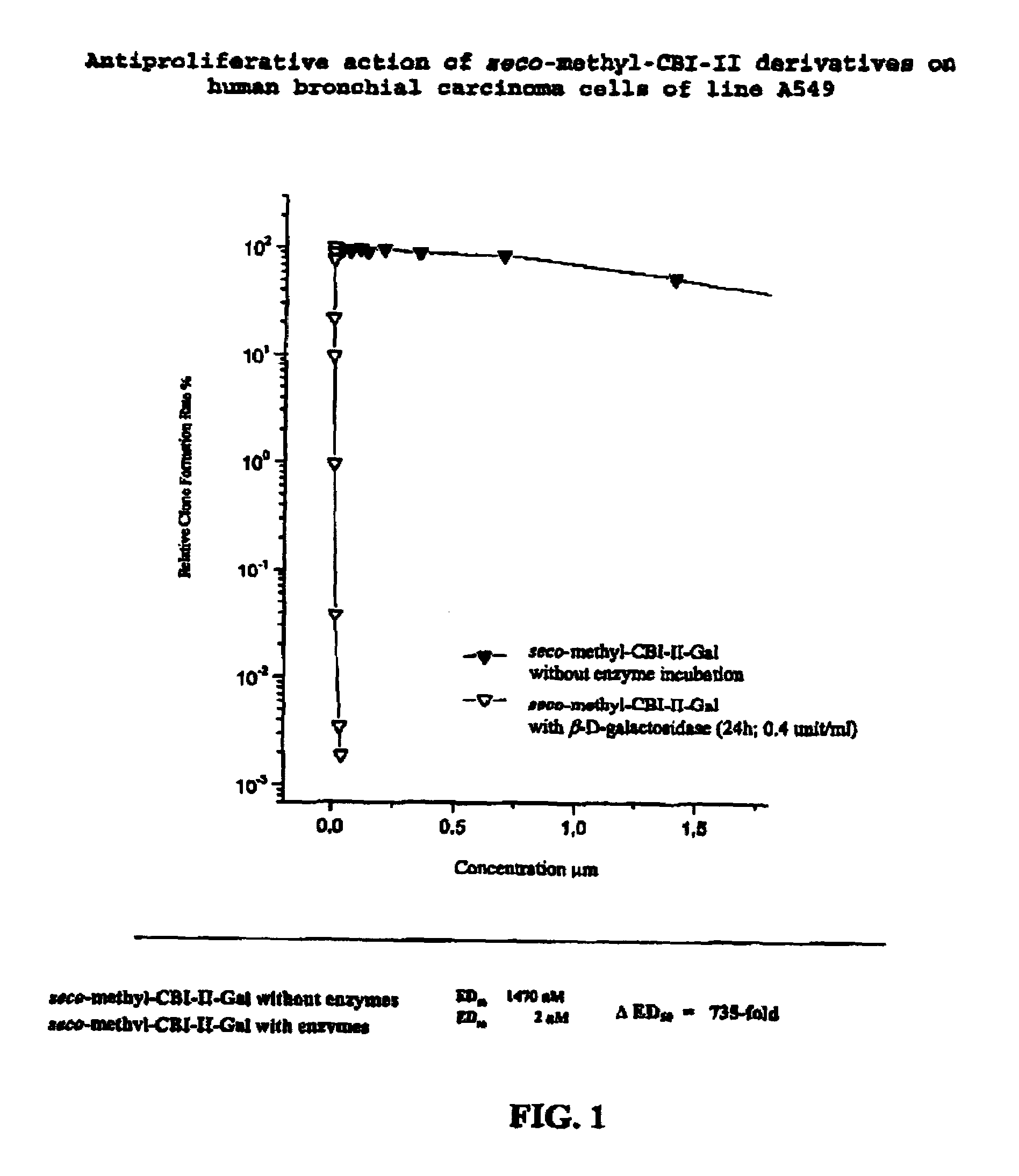Prodrugs for a selective cancer therapy
a cancer therapy and prodrug technology, applied in the direction of sugar derivatives, biocide, plant growth regulators, etc., can solve the problems of insufficient acid-labileness, insufficient cytotoxicity of prodrug and underlying drug, and inability to be acid-labile enough
- Summary
- Abstract
- Description
- Claims
- Application Information
AI Technical Summary
Problems solved by technology
Method used
Image
Examples
production example
Example 1
2-amino-4-benzyloxy-N-[E / Z-1′-(3′-chloro)-but-2′-enyl]-N-(tert.-butoxycarbonyl)-1-iodonaphthalene
[0067]
[0068]400 mg (10.0 mmoles) of sodium hydride in the form of a 60% suspension in paraffin oil were added to a solution of 2.00 g (4.21 mmoles) of 2-amino-4-benzyloxy-N-(tert.-butoxycarbonyl)-1-iodonaphthalene [produced for example according to D. L. Boger, J. A. McKie, J. Org. Chem. 1995, 60, 1271] in 50.0 ml of dry DMF. The reaction mixture was stirred for 45 minutes at room temperature and 1.20 ml (1.37 g, 10.9 mmoles) of an isomeric mixture of E / Z-1,3-dichlorobut-2-ene were added dropwise. The reaction mixture was then stirred for 3 hours at room temperature. After hydrolysis with saturated NH4Cl solution extraction was carried out three times with EtOAc. The combined organic phases were washed five times with water and then once with saturated NaCl solution and dried over Na2SO4. The solvents were removed in vacuo; a column chromatography purification of the residue (1...
example 2
5-benzyloxy-3-(tert.-butoxycarbonyl)-1-(1′-chloroethyl)-1,2-dihydro-3H-benzo[e]indole
[0070]
[0071]573 mg (1.02 mmoles) of the compound from Example 1 were dissolved in 18 ml of dry, degassed toluene and 0.35 ml (384 mg, 1.32 mmoles) of tributyltin hydride and 42.0 mg (255 μmoles) of AIBN were added thereto. The mixture was heated to 80° C. and stirred for 3.5 hours at this temperature. The residue obtained after concentration by evaporation was taken up in diethyl ether and washed with the same volume of a 10% aqueous solution of KF. The residue obtained after drying the organic phase over Na2SO4 and removal of the solvents was subjected to a column chromatography purification (100 g silica gel, 40–63 μm, solvent PE / EtOAc 20:1). 187 mg (419 μmoles, 42% yield) of the syndiastereomer and 180 mg (411 μmoles, 41% yield) of the antidiastereomer of the target compound were obtained.
Rf=0.52 (syn) and 0.32 (anti) (PE / EtOAc 10:1)
example 3
syn-3-(tert.-butoxycarbonyl)-1-(1′-chloroethyl)-5-hydroxy-1,2-dihydro-3H-benzo[e]indole
[0072]
[0073]354 mg (808 μmoles) of the syn-isomer of the compound from Example 2 were dissolved in 17.0 ml of acetone and 389 mg (366 μmoles) of 10% Pd on activated charcoal as well as 318 mg (5.05 mmoles) of ammonium formate were added thereto. The reaction mixture was stirred for 2 hours at 50° C. The reaction solution was filtered through celite that had been thoroughly washed with EtOAc. The residue obtained after concentrating the filtrate by evaporation was purified by column chromatography on silica gel (40 g, 40–63 μm, solvent PE / EtOAc 5:1) and thereby yielded 111 mg (320 μmoles, 85% yield) of the target compound.
[0074]Rf=0.48 (PE / EtOAc 5:1)
PUM
 Login to View More
Login to View More Abstract
Description
Claims
Application Information
 Login to View More
Login to View More - R&D
- Intellectual Property
- Life Sciences
- Materials
- Tech Scout
- Unparalleled Data Quality
- Higher Quality Content
- 60% Fewer Hallucinations
Browse by: Latest US Patents, China's latest patents, Technical Efficacy Thesaurus, Application Domain, Technology Topic, Popular Technical Reports.
© 2025 PatSnap. All rights reserved.Legal|Privacy policy|Modern Slavery Act Transparency Statement|Sitemap|About US| Contact US: help@patsnap.com



